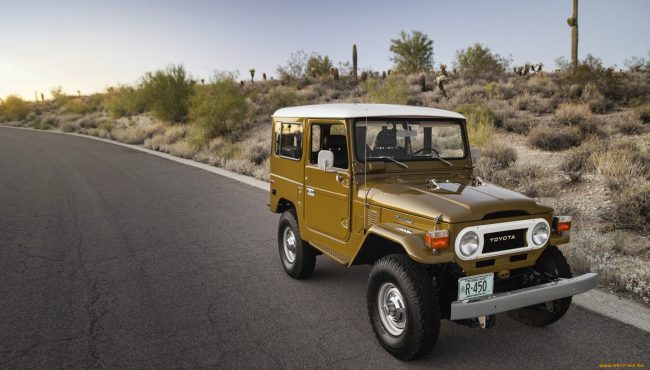
Toyota B series engines
Content
The first Toyota B-series diesel engine was developed in 1972. The unit turned out to be so unpretentious and omnivorous that the 15B-FTE version is still being produced and installed on Mega Cruiser cars, the Japanese analogue of the Hummer for the army.
Diesel Toyota B
The first ICE of the B series was a four-cylinder engine with a lower camshaft, a displacement of 2977 cm3. The cylinder block and head were made of cast iron. Direct injection, no turbocharging. The camshaft is driven by a gear wheel.
By modern standards, this is a low-speed engine, the peak torque of which falls at 2200 rpm. Motors with such characteristics are ideal for overcoming off-road and transporting goods. Acceleration dynamics and top speed leave much to be desired. A Land Cruiser with such an engine could keep up with the classic Zhiguli only up to a speed of 60 km / h, while rattling like a tractor.

Unsurpassed survivability can be considered an unsurpassed advantage of this motor. It works on any oil, digests almost any liquid smelling of diesel fuel. The engine is not prone to overheating: they describe the case when a Land Cruiser with such an engine worked without any problems for several months with a shortage of 5 liters of coolant.
An in-line high pressure fuel pump is as reliable as the engine as a whole. Car service workers rarely diagnose this node, they believe that there is nothing to break there. The only trouble that occurs over time is the displacement of the fuel injection angle to a later side due to wear on the timing drive gears and the high-pressure fuel pump camshaft. Adjusting the angle is not particularly difficult.
The most vulnerable components of the motor are nozzle sprayers. They stop spraying fuel normally after about 100 thousand km. But even with such injectors, the car continues to start and drive confidently. In this case, power is lost, and smoke increases.
But you should not do this. There is an opinion that faulty injectors cause coking of the piston rings, which will require an overhaul of the engine. A complete overhaul of the motor, taking into account the cost of spare parts, will result in the amount of 1500 USD. Much easier to clean up the injectors.
The motor was installed on the following cars:
- Land Cruiser 40;
- Toyota Dyna 3,4,5 generation;
- Daihatsu Delta V9/V12 series;
- Anthem Ranger 2 (V10).
3 years after the start of production, motor B underwent modernization. Version 11 B appeared, on which fuel injection was applied directly into the combustion chamber. This decision increased the engine power by 10 horsepower, the torque increased by 15 Nm.
Diesel Toyota 2B
In 1979, the next upgrade was carried out, the 2B engine appeared. The engine displacement was increased to 3168 cm3, which gave an increase in power by 3 horsepower, torque increased by 10%.
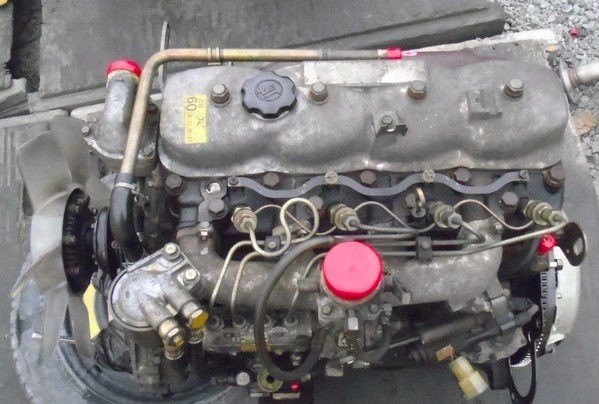
Structurally, the engine remained the same. The head and cylinder block were cast from cast iron. The camshaft is located at the bottom, in the cylinder block. The valves are driven by pushers. There are two valves per cylinder. The camshaft is driven by gears. The oil pump, vacuum pump, injection pump are driven by the same principle.
Such a scheme is extremely reliable, but has increased inertia due to the large number of links. In addition, numerous parts produce significant noise. To combat it, the 2B motor used gears with oblique teeth, which were lubricated through a special nozzle. The lubrication system is gear type, the water pump was driven by a belt.
The 2B engine adequately continued the tradition of its predecessor. It is characterized as an extremely reliable, durable, unpretentious unit that is suitable for SUVs, light buses and trucks. The motor was installed on Toyota Land Cruiser (BJ41/44) and Toyota Coaster (BB10/11/15) for the domestic market until 1984.
Motor 3B
In 1982, the 2B was replaced by the 3B engine. Structurally, this is the same four-cylinder lower diesel engine with two valves per cylinder, in which the working volume is increased to 3431 cm3. Despite the increased volume and increased maximum speed, power fell by 2 hp. Then there were more powerful versions of the engine - 13B, equipped with direct fuel injection and 13B-T, which has a turbocharger. In more powerful versions, an upgraded pump of a reduced size was installed and a trochoid, instead of a gear, oil pump.
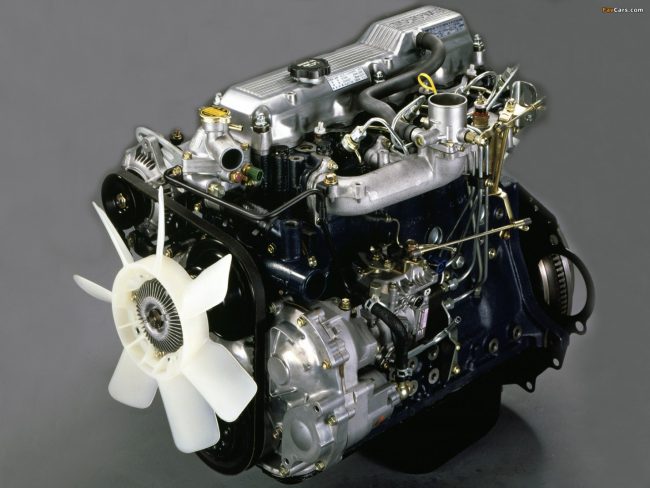
An oil cooler was installed between the oil pump and filter on the 13B and 13B-T engines, which was a heat exchanger cooled by antifreeze. The changes led to an increase in the distance between the oil intake and the pump by almost 2 times. This slightly increased the engine's oil starvation time after starting, which did not have the best effect on durability.
3B series motors were installed on the following vehicles:
- Dyna (4th, 5th, 6th generation)
- Toyoace (4th, 5th generation)
- Land Сruiser 40/60/70
- Coaster bus (2nd, 3rd generation)
Engines 13B and 13B-T were installed only on the Land Cruiser SUV.
4B engine
In 1988, the 4B series engines were born. The working volume increased to 3661 cm3. The increase was obtained by replacing the crankshaft, which increased the piston stroke. The cylinder diameter remained the same.
Structurally, the internal combustion engine completely repeated its predecessor. This engine did not receive distribution; its modifications 14B with direct injection and 14B-T with turbocharging were mainly used, which have higher power and efficiency. The 4B engine in its pure form was significantly inferior to its competitors in these parameters. 14B and 14B-T were installed on Toyota Bandeirante, Daihatsu Delta (V11 series) and Toyota Dyna (Toyoace) vehicles. Motors were produced until 1991, in Brazil until 2001.
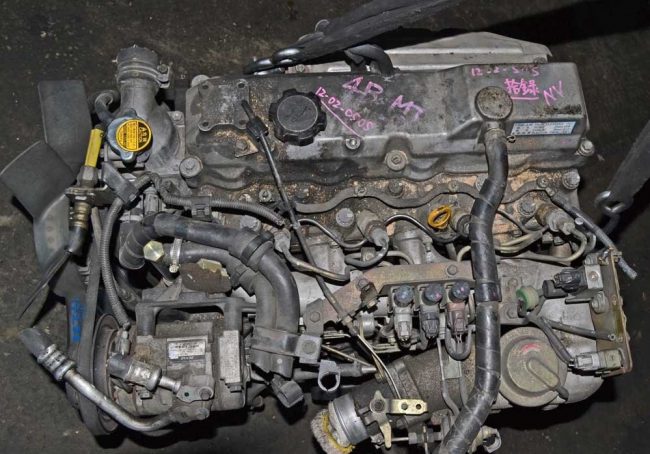
15B engine
The 15B-F, 15B-FE, 15B-FTE motors, introduced in 1991, complete the range of B-series engines. 15B-FTE is still in production and installed on the Toyota Megacruiser.
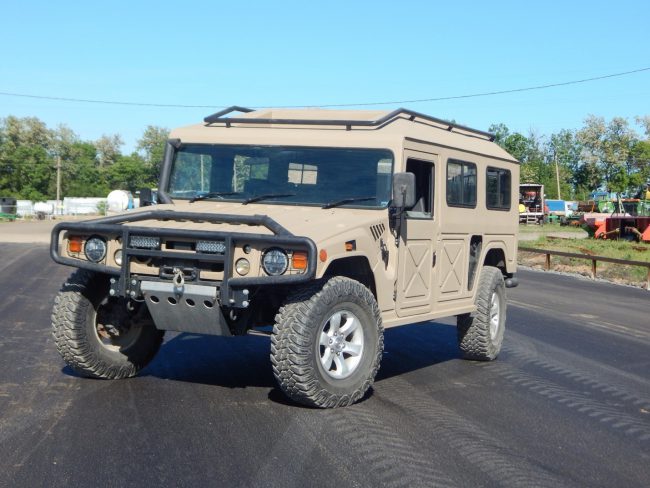
In this engine, the designers abandoned the lower scheme and used the traditional DOHC system with narrow cams. The camshaft is located in the head above the valves. Such a scheme, using a turbocharger and an intercooler, made it possible to achieve acceptable traction characteristics. Maximum power and torque are achieved at lower rpm, which is what is required for an army all-terrain vehicle.
Technical specifications
The following is a summary table of the technical specifications of B-series engines:
| Engine | Working volume, cm3 | Direct injection available | The presence of turbocharging | The presence of an intercooler | Power, hp, at rpm | Torque, N.m, at rpm |
|---|---|---|---|---|---|---|
| B | 2977 | no | no | no | 80 / 3600 | 191/2200 |
| 11B | 2977 | Yes | no | no | 90 / 3600 | 206/2200 |
| 2B | 3168 | no | no | no | 93 / 3600 | 215/2200 |
| 3B | 3431 | no | no | no | 90 / 3500 | 217/2000 |
| 13B | 3431 | Yes | no | no | 98 / 3500 | 235/2200 |
| 13B-T | 3431 | Yes | Yes | no | 120/3400 | 217/2200 |
| 4B | 3661 | no | no | no | n / a | n / a |
| 14B | 3661 | Yes | no | no | 98/3400 | 240/1800 |
| 14B-T | 3661 | Yes | Yes | no | n / a | n / a |
| 15B-F | 4104 | Yes | no | no | 115/3200 | 290/2000 |
| 15B-FTE | 4104 | Yes | Yes | Yes | 153 / 3200 | 382/1800 |
Engine 1BZ-FPE
Separately, it is worth dwelling on this internal combustion engine. 1BZ-FPE is a four-cylinder engine with a working volume of 4100 cm3 with a 16 valve head and two camshafts driven by a belt.
The internal combustion engine was adapted to work on liquefied gas - propane. Maximum power - 116 hp at 3600 rpm. Torque is 306 Nm at 2000 rpm. In fact, these are diesel characteristics, with high traction at low speeds. Accordingly, the motor was used in commercial vehicles such as Toyota Dyna and Toyoace. The power system is a carburetor. Cars regularly performed their functions, but had a small power reserve on gas.
Reliability and durability of B-series motors
The indestructibility of these motors is legendary. A fairly simple design, a large margin of safety, the ability to repair "on the knee" made these units indispensable in off-road conditions.
Turbocharged engines do not differ in such reliability. The technology of supercharging engines did not reach the degree of perfection at that time that it is today. Turbine support bearings often overheated and failed. This can be avoided if the engine is allowed to idle for several minutes before shutting down, which was not always observed and not by everyone.
Possibility to purchase a contract engine
There is no lack of supply, especially in the Far East market. Motors 1B and 2B are more difficult to find in good condition, since such motors have not been produced for a long time. Their prices start at 50 thousand rubles. Motors 13B, 14B 15B are offered in large quantities. A contract 15B-FTE with a large residual resource that has not been used in the CIS countries can be found at a price of 260 thousand rubles.

